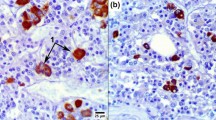Summary
Proliferation of pituitary basophil cells and occasional chromophobe and eosinophil cells into the posterior lobe was found in 61.8±6.9% (α=0.05) in routine necropsy series. The incidence and intensity of proliferation increased in accordance with increasing age. There were no sex differences. The cells were for the most part ACTH-productive; only a few were found to produce somatotropic hormone (STH) or prolactin in exceptional cases, when examined immunocytochemically. Proliferation of these cells appears to take place postnatally, probably in young adult ages. Basophil proliferation, stemming from the pars intermedia, was not related to any clinical features. However, in 6 out of 191 examined cases (3.1±2.5%), the proliferating cells displayed neoplastic potentiality, demonstrated as a combination of mitoses, multinuclear cells, polymorphism, and hypertrophy of the protoplasma in addition to intense proliferation. This finding, described for the first time, may contribute to a better understanding of the origin of silent corticotrophic cell adenomas.
Similar content being viewed by others
References
Bargmann W (1977) Histologie und mikroskopische Anatomie des Menschen. Thieme, Stuttgart, pp 319–334
Boyd JD (1956) Observations on the human pharyngeal hypophysis. J Endocrinol 14: 66–77
Burrows GN, Wortzman G, Rewcastle NB, Holgate RC, Kovacs K (1981) Microadenomas of the pituitary and abnormal sellar tomograms in an unselected autopsy series. New Engl J Med 304: 156–158
Gorczyca W, Hardy J (1988) Microadenomas of the human pituitary and their vascularization. Neurosurgery 22: 1–6
Hassoun J, Charpin C, Jaquet P, Oliver C, Lissitzky JC, Grisoli F, Toga M (1979) Analogies immunocytochimiques des adenomes hypophysaires de la maladie de Cushing et des adenomes “non fonctionnels” (adenomes chromophobes) de l'hypophyse. A propos de 13 cas. Ann Endocrinol (Paris) 40: 559–560
Hori A (1985) Suprasellar peri-infundibular ectopic adenohypophysis in fetal and adult brains. J Neurosurg 63: 113–115
Horvath E, Kovacs K, Killinger DW, Smyth S, Platts ME, Singer W (1980) Silent corticotropic adenomas of the human pituitary gland. A histologic, immunocytologic, and ultrastructural study. Am J Pathol 98: 617–638
Kovacs K, Horvath E, Bayley TA, Hassaram ST, Ezrin C (1978) Silent corticotroph cell adenoma with lysosomal accumulation and crinophagy. A distinct clinicopathologic entity. Am J Med 64: 492–499
Kovacs K, Horvath E (1986) Tumors of the pituitary gland. Atlas of tumor pathology, second series, Fasc 21. Armed Forces Inst Pathol, Washington, pp 150–164
Moriarty GC (1973) Adenohypophysis: ultrastructural cytochemistry. A review. J Histochem Cytochem 21: 855–894
Neilson K, Chadarévian JP (1987) Ectopic anterior pituitary corticotropic tumor in a six-year-old boy. Histological, ultrastructural and immunocytochemical study. Virchows Arch A 411: 267–273
Parent AD, Brown B, Smith EE (1982) Incidental pituitary adenomas: a retrospective study. Surgery 92: 880–883
Rasmussen AT, Nelson AA (1938) Pars intermedia basophil adenoma of the hypophysis. Am J Pathol 14: 297–310
Saeger W, Schroeder H (1985) ACTH-Zellhyperplasien der Adeno- und der Neurohypophyse und ihre Beziehungen zur arteriellen Hypertonie. Pathologe 6: 141–148
Schwesinger G, Warzok R (1982) Hyperplasien und Adenome der Hypophyse im unselektierten Sektionsgut. Zbl Pathol 126: 495–498
Tramu G, Beauvillain JC, Mazzuca M, Fossati P, Martin-Linquette A, Christiaens JL (1976) Dissociation des résultats obtenus en immunofluorescence avec des antisérums anti-ACTH dans trois cas d'adénomes “chromophobe” sans hypercorticisme. Etude ultrastracturale. Ann Endocrinol (Paris) 37: 55–56
Tramu G, Beauvillain JC, Mazzuca M, Linquette M, Lefebvre J, Fossati P, Christiaens JL (1978) Adénom hypophysaire à cellules à α, 17–39 ACTH et Β, MSH sans hypercorticisme. Ann Endocrinol (Paris) 39: 51–52
Author information
Authors and Affiliations
Additional information
This paper is a part of a doctoral thesis (S.K.) at the University of Goettingen, Federal Republic of Germany.
Rights and permissions
About this article
Cite this article
Kuebber, S., Ropte, S. & Hori, A. Proliferation of adenohypophyseal cells into posterior lobe. Acta neurochir 104, 21–26 (1990). https://doi.org/10.1007/BF01842888
Issue Date:
DOI: https://doi.org/10.1007/BF01842888




